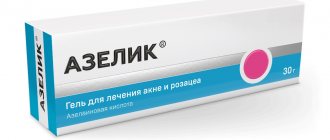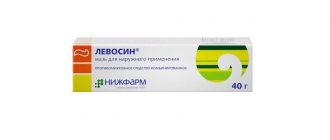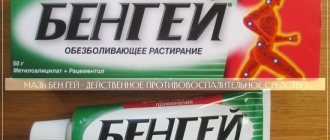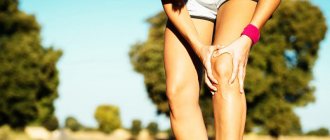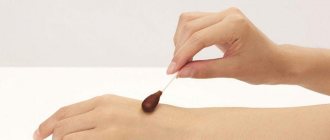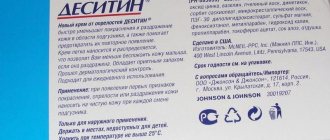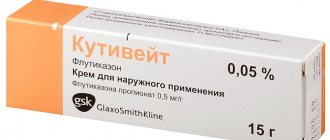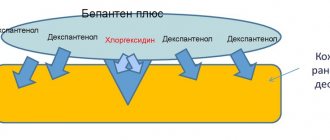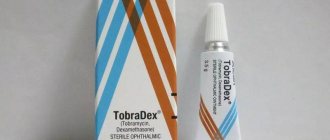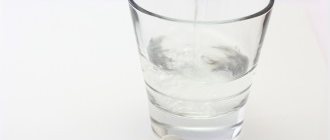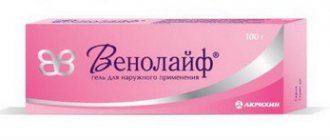Pharmacological properties of the drug Dolobene
Combined preparation for external use. Dimethyl sulfoxide has an anti-inflammatory, anti-exudative and local analgesic effect due to the inactivation of hydroxyl radicals and improvement of metabolic processes in the site of inflammation, reducing the speed of nociceptive impulses in peripheral neurons, as well as the presence of hygroscopic properties; facilitates the resorption of other ingredients of the drug. Heparin is a direct anticoagulant, a natural anticoagulant of the body, has an anti-inflammatory effect, promotes the regeneration of connective tissue by inhibiting the activity of hyaluronidase; prevents thrombus formation, activates fibrinolytic properties of blood; improves local blood flow. Dexpanthenol, a derivative of vitamin B5, is converted in the skin into pantothenic acid, which is part of coenzyme A, which plays an important role in the processes of acetylation and oxidation. By improving metabolic processes, it promotes the regeneration of damaged tissues. After a single application of 1.5 g of Dolobene to a skin surface area of 4 cm2, dimethyl sulfoxide is resorbed with an absorption half-life of 3–4 hours. 6 hours after application, its concentration in the blood reaches approximately 120 ng/ml, a level that persists for 12 hours. Period half-life from blood plasma is 11–14 hours. 60 hours after application, the level of dimethyl sulfoxide corresponds to its endogenous concentration in blood plasma as a natural substance of the body (on average 40 ng/ml). Dimethyl sulfoxide passes into breast milk. Eliminated primarily in urine. Heparin sodium does not cross the placental barrier and does not enter breast milk. The pharmacokinetics of dexapanthenol have not been studied.
Composition and release form
Dolobene gel (ointment) for external use is available in 50 ml tubes, in a cardboard box. The product has a yellowish tint and a thick consistency.
Pharmacological group - an anticoagulant agent for local use, relieves the feeling of heaviness in the muscles, helps to resolve hematomas, and has an analgesic effect. Used in a course for external application.
Composition of ingredients of Dolobene ointment:
- active ingredients: Dexpanthenol, Sodium Heparin, Dimethyl sulfoxide;
- mountain pine oil;
- rosemary oil;
- isopropanol;
- lemongrass oil;
- polyacrylic acid;
- purified water;
- trometamol
The ointment is effective for varicose veins and spider veins, since the active substance Heparin enhances the activity of antithrombin III. It is recommended for prophylactic use when using oral contraceptives, to strengthen the walls of blood vessels and prevent varicose veins.
Use of the drug Dolobene
For adults and children over 5 years of age, apply the gel in a thin layer (for example, a column of gel 3 cm long is applied to an area the size of which corresponds to the projection of the knee joint) on or around the affected areas (for abrasions), evenly distributed over the surface of the skin with light rubbing movements 2 –4 times a day. When applying dressings with Dolobene gel, a breathable dressing material is used only after most of the gel has penetrated the skin and the alcohol contained in the preparation has evaporated (several minutes). When using the ion-phoretic method of drug administration, the gel is applied under the cathode, taking into account the anionic properties of heparin, which is part of Dolobene. In phonophoresis, the preparation, which is a suitable contact gel and contains active substances, complements the physiotherapeutic effect of ultrasonic waves. The duration of treatment for Dolobene is individual and depends on the severity of the disease, as well as the effectiveness of therapy.
Analogs
The pharmaceutical industry produces several dozen, if not hundreds, of anticoagulants. In fact, these are direct analogues of Dolobene gel with a similar mechanism of action.
The following drugs deserve special attention:
- "Hepatrombin S";
- "Venabos";
- "Anfiba";
- "Venolife";
- "Lioton 1000";
- "Voltaren."
Only the attending physician can determine a suitable substitute, based on the clinical picture of the pathological process, the presence of contraindications in the patient and associated complications.
Side effects of the drug Dolobene
Possible skin hyperemia, itching and burning sensation at the site of application of the drug; temporary appearance of garlicky breath (due to the presence of dimethyl sulfide, a metabolite of dimethyl sulfoxide). This smell indicates good absorption of dimethyl sulfoxide. Changes in taste sensations, which sometimes occur immediately after applying the gel, usually disappear after a few minutes. Isolated cases of the development of immediate allergic reactions (urticaria, Quincke's edema) have been described.
Indications for use
Dolobene ointment has proven itself in many cases; the main indications for the use of this drug are:
- hematomas, bruises, swelling that occurred from traumatic causes - external application of Dolobene quickly eliminates inflammation and reduces swelling in a matter of days. In this case, the ointment helps strengthen blood vessels;
- muscle inflammation;
- inflammatory processes in soft tissues, tendons, tendonitis;
- traumatic disorders in the joints;
- sprain of ligaments and tendons - the product quickly eliminates the symptoms of these injuries in the form of swelling and pain, Dolobene components accelerate metabolism, due to which the ligaments are restored faster;
- bursitis;
- thrombophlebitis - a course of use of Dolobene can restore damaged skin, strengthen the walls of blood vessels and veins, the medicine will not allow blood clots to increase in size;
- arthrosis - for this disease, the use of ointment accelerates metabolism and blood microcirculation in the diseased area, slows down the breakdown of cartilage tissue, and prevents the disease from progressing;
- arthritis – Dolobene removes inflammatory processes in joints, relieves pain;
- myositis - applying Dolobena gel for a course of 5 days will completely relieve the symptoms of the disease and the inflammatory process;
- varicose veins – used for varicose veins of the legs, helps prevent the progression of the disease, removes the feeling of heaviness and cramps in the legs;
- neuralgia of any etymology – Dolobene prevents relapse of neuralgia.
Special instructions for the use of the drug Dolobene
To prevent unwanted effects, the drug is applied to clean skin. Other medications should not be applied for several hours before or after using Dolobene. The drug should not be applied to the mucous membrane, wound surface or damaged skin (for example, after irradiation, with dermatitis, dermatoses, postoperative scars, burns). The drug does not leave an oily sheen on the skin or marks on clothes. After applying the drug, a feeling of coolness occurs (due to the alcohol content).
Reviews
Inga, Stavropol
I constantly encounter bruises and hematomas on my body, I work as an instructor in women's self-defense. In a word - the costs of the profession. Russian analogues of Dolobene gel (Hepatrombin S, Heparin ointment, etc.) simply could not cope with so many bruises and the regularity of their appearance on the body. Only Dolobena helped. Bruising goes away within 2-3 days. Now I’m attentive to my workouts, I don’t allow unnecessary injuries, but a first aid kit with this gel is always at hand.
Read further:
Betamethasone ointment: instructions for use, review and reviews
Boromenthol ointment: instructions for use, review and reviews
Aertal ointment: instructions for use, review and reviews
Biopin ointment: instructions for use, review and patient reviews
Afloderm ointment: instructions for use and patient reviews
Dolobene gel (review) from 350 rub.
Overall
4.3
- Efficiency
- Price
- Safety
- Availability
Pros
- Doesn't stain clothes
- Efficiency
- Quickly absorbed
Cons
- High consumption
- Price
- Smell
Indications and contraindications
Dolobene gel has anti-edematous, anti-inflammatory and analgesic properties, so it has a wide range of applications. This universal remedy can be used for injuries to soft tissues, skin, and the musculoskeletal system.
The drug helps in the following cases:
- closed injuries;
- bruises;
- arthritis and arthrosis;
- sprain;
- radiculitis;
- osteochondrosis;
- hernia;
- inflammation of muscles, joints, soft tissues;
- swelling;
- acute neuralgia.
The product also helps well with varicose veins . It prevents the disease from progressing and prevents complications from occurring. Thanks to heparin, the blood in the veins is thinned, swelling is eliminated, and the number of blood clots is reduced. The drug can be used for thrombophlebitis. It prevents the formation of new blood clots, and makes existing ones less pronounced.
Dolobene can be used to combat bruises and swelling under the eyes . The product will improve tissue metabolism and make the skin more elastic. It should be used with extreme caution, as it contains alcohol, which is quite dangerous to eyesight. This drug gives a good effect when eliminating cones after an injection. It accelerates blood circulation in the muscles and promotes better resorption of the infiltrate.
Despite the great effectiveness of the drug, in some cases it is prohibited to use it on the skin. For example, the product should not be used for bronchial asthma , as it can cause narrowing of the bronchi. The drug is also contraindicated in cases of serious impairment of liver and kidney function. The main part of the active components is excreted through these organs, and if their functioning is disrupted, severe poisoning of the body can occur. Contraindications also include hypersensitivity to the components of the drug.
It is not recommended to use the gel during pregnancy, as it can provoke premature placental abruption and interfere with oxygen access to the fetus. It is also undesirable to use the drug during breastfeeding, since the active ingredients of the medication may enter the baby’s body along with the milk.
After a single use of the drug, dimethyl sulfoxide will be completely eliminated from the woman’s body only after seven days, so it is advisable to resume feeding on the eighth day after treatment. The gel is contraindicated for children under five years of age. It should not be applied to open wounds as it thins the blood, increasing bleeding.
If the drug is used incorrectly, side effects may occur. , nausea, diarrhea, dizziness, or severe headaches may occur The same phenomena occur with an overdose.
The medication may cause an allergic reaction in the form of a rash, redness of the skin, burning, itching, and peeling. The medicine may cause fever, weakness and fatigue. In this case, you should immediately stop using the gel and wash off its residue from the skin with cool water. If after this the condition does not improve, then you should immediately seek help from your doctor. It is extremely rare that the drug can cause bad breath. This is due to the fact that some of the active components are excreted from the body through the lungs.
